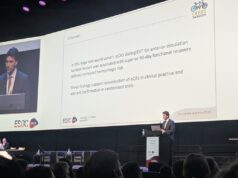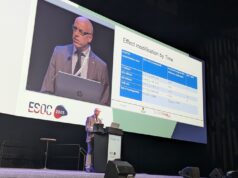
A randomised trial has found mechanical thrombectomy procedures performed within 24 hours of symptom onset to be more effective than standard medical care in treating acute ischaemic strokes caused by anterior circulation large vessel occlusions (LVOs) with a large infarct core, resulting in improved functional outcomes at three months.
Delivering data from the ANGEL-ASPECT study at the International Stroke Conference (ISC; 8–10 February 2023, Dallas, USA), principal investigator Zhongrong Miao (Capital Medical University, Beijing, China) reported that, while the trial met its primary efficacy endpoint, indicating improved outcomes with thrombectomy versus standard care, the procedure was also linked to an increase rate of intracranial haemorrhages (ICHs).
Miao began by noting that, while mechanical thrombectomy has become the standard approach to LVO ischaemic stroke following positive results in MR CLEAN, ESCAPE, REVASCAT and multiple other randomised controlled trials (RCTs), these studies have “almost entirely excluded” patients with a large infarct-core volume.
The role of thrombectomy in large-infarct stroke has not been extensively studied in differing populations, the speaker continued. However, a handful of previous studies have shown some benefit to thrombectomy in these patients—including the RESCUE-Japan LIMIT trial and SELECT2, with the latter also being presented for the first time at ISC 2023. Additional, ongoing trials in this space include TENSION in Europe and TESLA in the USA.
In the ANGEL-ASPECT RCT, which aimed to further assess thrombectomy-associated outcomes in these large-infarct strokes, patients were included based on their non-contrast computed tomography (CT) Alberta stroke programme early CT score (NCCT-ASPECTS).
The 46 centres that ultimately participated in ANGEL-ASPECT were spread across 20 Chinese provinces, with the trial’s enrolment progress starting in October 2020 and being halted early due to efficacy of endovascular thrombectomy treatments being detected at the interim analysis in May 2022.
A total of 456 patients had follow-up data available at the 90-day follow-up timepoint on 13 August, Miao reported. After one patient withdrew consent, 230 of these patients (median age=68 years, 58.7% male) were randomised to the trial’s thrombectomy group, with 225 (median age=67, 64% male) being allocated standard medical care. Miao informed the ISC audience that there were no significant differences in baseline demographic/clinical data between the two groups, and more than 60% of patients underwent treatment 6–24 hours after symptom onset.
In the intention-to-treat analysis, findings as per the primary endpoint showed a shift towards better outcomes in the distribution of 90-day modified Rankin Scale (mRS) scores in favour of thrombectomy. The average mRS score at 90 days was 4 in both the thrombectomy group (range 2–5) and the standard care group (range 3–5). However, Miao and colleagues found a treatment effect of 1.37 (generalised odds ratio; p=0.004) with thrombectomy.
Overall, 30% of patients in the thrombectomy group achieved a 90-day mRS score of 0–2, versus 11.6% in the standard care group, with these rates increasing to 47% and 33.3%, respectively, for mRS 0–3. Improved National Institutes of Health Stroke Scale (NIHSS) scores at 36 hours, and reduced infarct core volumes from baseline, were also observed, as per the trial’s secondary efficacy outcomes.
“The efficacy for the primary outcome was similar across predefined subgroups and across all sites, but the trial was underpowered for these analyses,” the speaker added. “The primary outcome results of the per-protocol analysis were similar to the intention-to-treat analysis.”
Regarding safety outcomes, Miao relayed that 14 symptomatic ICHs (6.1%) and 113 ICHs overall (49.1%) occurred within 48 hours in the thrombectomy group, compared to six (2.7%) and 39 (17.3%), respectively, in the standard care group. Mortality rates—21.7% with thrombectomy and 20% without—were similar between the two groups, but more decompressive hemicraniectomy procedures were required during hospitalisation in the thrombectomy group.
Briefly outlining potential limitations of ANGEL-ASPECT, Miao said the proportion of patients receiving intravenous thrombolysis (IVT) was low, “which may have disadvantaged the medical treatment group”, and the fact the trial was conducted among Chinese patients—in whom there is a higher proportion of intracranial artery stenosis—means the findings may not be generalisable to other populations.
“Verification of our findings is required,” he concluded, also highlighting the recent publication of the ANGEL-ASPECT trial in the New England Journal of Medicine (NEJM).
An editorial authored by Pierre Fayad (University of Nebraska Medical Center, Omaha, USA), which appears alongside the publications of ANGEL-ASPECT and the SELECT2 trial in NEJM, notes that, despite differences in design, patient selection, thrombolytic treatment/dose, geographic location, and imaging criteria, recent RCTs in large-infarct stroke patients have showed “remarkably similar results”.
“Together, the trials provide reassuring information from more than a thousand patients with large ischaemic strokes in different medical systems that will probably lead to changes in patterns of care delivery,” Fayad writes. “It is reasonable to suggest that endovascular thrombectomy be offered to patients with large strokes […] if they arrive in a timely fashion at a centre that is capable of performing the procedure, and if the patients have an ASPECTS value of 3–5 or an ischaemic-core volume of 50ml or greater. Higher rates of ‘good outcomes’ may be anticipated if this treatment is performed, despite increased risks of symptomatic haemorrhage, oedema, neurologic worsening, and hemicraniectomy.”









